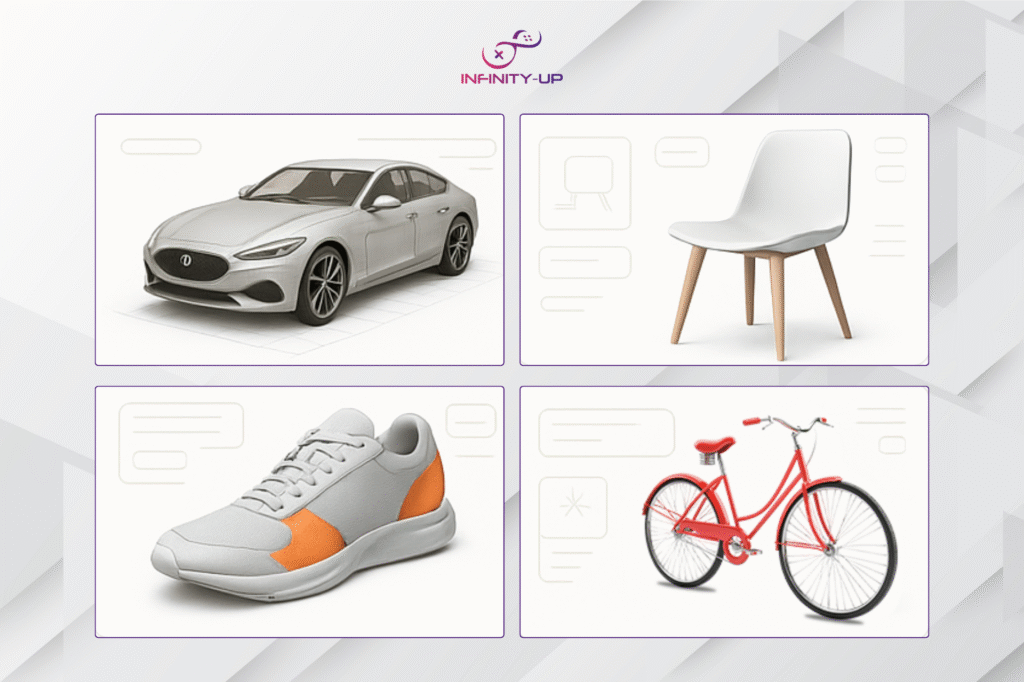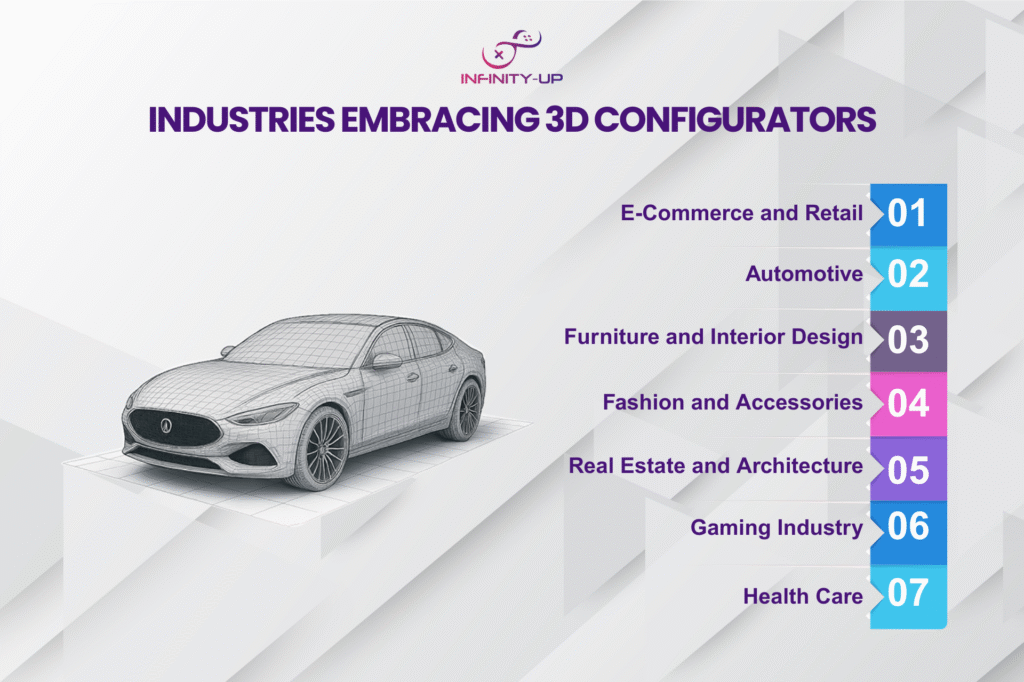Future of Interactivity: Power of 3D Configurators
Future of Interactivity: Power of 3D Configurators
3D configurators are revolutionizing the customer experience. By enabling personalized product visualization and modification, these engaging tools enhance user engagement, drive sales conversions, and improve customer satisfaction.
What are 3D configurators?
A 3D configurator is an innovative, playful tool that lets users customize and visualize products in real time through an intuitive 3D interface. Customers can personalize every detail, texture, and size, and feature-creating a unique, hyper-realistic product tailored to their needs. In gaming, 3D configurators elevate the experience by enabling players to customize characters, environments, vehicles, and assets with precision. For developers, this technology boosts productivity, speeding up asset creation and design iterations. Elevate user experiences and optimize your development workflow with the transformative capabilities of 3D configurators!

Industries Embracing 3D Configurators
E-Commerce and Retail:
Boosting e-commerce conversion rates can be challenging when customers can’t physically interact with products. 3D product configurators offer a powerful solution by delivering an immersive shopping experience that closely mimics the in-store feel. With 360-degree product views and customizable options, shoppers gain a deeper understanding of the product, leading to increased purchase confidence and significantly lower product return rates. This translates to higher customer satisfaction and ultimately, a stronger bottom line for your online store.
Automotive:
Automotive companies have been pioneering the implementation of 3D product configurators, which allow prospective buyers to customize their dream vehicles precisely. From selecting exterior colors and trims to choosing wheel designs and interior options, customers can visualize their ideal car in stunning detail. This immersive and responsive experience not only boosts user engagement and enhances the customer journey but also provides invaluable data-driven insights into consumer preferences, enabling companies to tailor their offerings and drive sales more effectively.
Furniture and Interior Design:
Customizing furniture and home decor is another area where 3D configurators excel. Users can mix and match materials, colors, and dimensions while previewing how the pieces will look in their spaces, often using augmented reality (AR) integration for added convenience.
Fashion and Accessories:
Fashion brands leverage 3D configurators to meet the rising demand for personalized products. Customers can customize everything from sneakers to eyewear, fostering a stronger sense of brand loyalty. These engaging tools enhance the customer experience, driving sales and differentiating brands in a competitive market.
Real Estate and Architecture:
Immerse yourself in the future of home buying with 3D configurators. Explore properties virtually, customize layouts, visualize finishes, and furnish spaces to bring your dream home to life. Make informed decisions and close deals faster with this engaging and interactive experience.
- Gaming Industry:
The gaming industry is rapidly adopting 3D configurators to boost player engagement and modification. These tools enable users to personalize characters, weapons, and environments in real-time, enhancing the immersive experience. For developers, 3D configurators simplify design workflows, save development time, and encourage creativity with dynamic prototyping. They also create new revenue opportunities through in-app purchases of customizable items, driving increased profitability. However, developers face Challenges in Gamification that must be addressed to maintain engagement and ensure the effectiveness of game mechanics.
- Health Care
The healthcare industry is leveraging 3D configurators to revolutionize patient care and medical training. These tools enable the adaptation of prosthetics, implants, and surgical guides tailored to individual needs. They also provide immersive simulations for medical training, enhancing skill acquisition and procedural accuracy. By improving precision and personalization, 3D configurators are transforming healthcare delivery and patient outcomes.

Benefits of 3D Configurators
Enhanced Visualization:
Customers can explore products in 360-degree views, customize colors and features in real-time, and use virtual staging to visualize furniture layouts in spaces like homes or offices. This enhances realism and aids decision-making.
Improved Decision Making:
Visualizing products in 3D reduces uncertainty, helps customers make informed decisions, and minimizes the risk of buyer’s remorse. It builds trust and confidence in purchases while offering a personalized experience through tailored options, ultimately enhancing customer satisfaction.
Cost Effectiveness:
3D configurators reduce prototyping costs by replacing physical models and help optimize inventory through insights into customer preferences.
Marketing and Branding:
3D configurators boost engagement, enhance brand awareness, and provide a competitive edge with innovative and immersive features.
The Technology Behind 3D Configurators
Creating a seamless 3D configurator experience involves integrating several cutting-edge technologies:
- 3D Modeling Software: Tools like Blender, Maya, and 3ds Max are used to create highly detailed product models.
- Rendering Engines: Platforms such as Unity, Unreal Engine, and WebGL power the real-time resolution of 3D objects.
- Augmented Reality (AR): AR extensions allow users to place virtual products in real-world environments, enhancing the configurator’s utility.
- Web Development Frameworks: Libraries like Three.js and Babylon.js enable developers to embed 3D configurators directly into websites.
Challenges and Future Potential With INFINITY-UP
3D configurators present challenges like high development costs, performance optimization, and cross-platform compatibility. However, with the rapid advancement of technology, these obstacles are expected to lessen, unlocking greater potential. INFINITY-UP, with its expertise in full-stack game development, 2D/3D art, and XR solutions, is well-positioned to leverage these advancements. By integrating AI, AR/VR, and blockchain, INFINITY-UP can drive the future of 3D configurators in gaming, offering personalized and immersive experiences in the Metaverse and beyond, where gamers can co-create their virtual worlds, bridging the gap between player and developer.
Conclusion
3D configurators are revolutionizing industries, from gaming to retail. By empowering customers with unprecedented adaptation and providing businesses with crucial data, these tools are driving innovation and enhancing the customer experience. As the digital landscape evolves, 3D configurators will become an indispensable tool for businesses seeking to thrive in the competitive market. Reach out to us today to start a collaboration.
FAQ
Q1: What are the benefits of using 3D configurators?
A: 3D designers improve customer experience by illustrating engaging objects. This helps customers see their options more accurately, reducing errors and returns. By displaying how to personalize experiences, they drive sales and provide valuable data for companies to understand consumer preferences.
Q2: How can 3D configurators improve customer engagement and conversion rates?
A: 3D planners increase customer engagement by allowing experimental searches. This personalized experience builds customer confidence, increasing conversion.
Q3: What role will 3D configurators play in the gamification of product experiences?
A: 3D configurators gamify product experiences by turning adjustments into an engaging game. This playful approach enhances engagement and makes product exploration more enjoyable.

